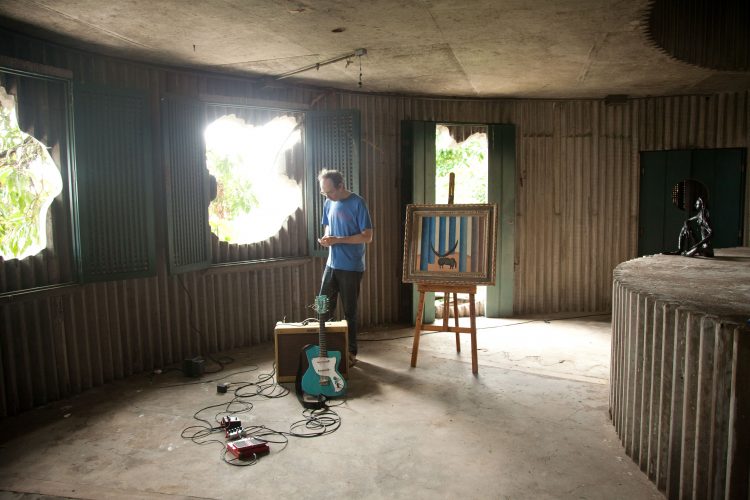
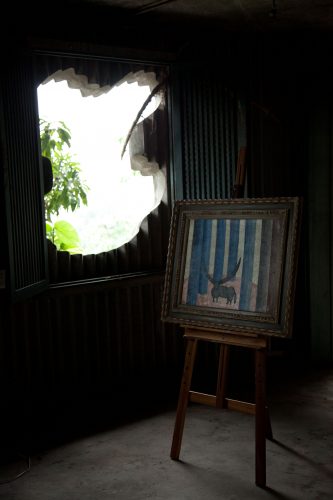
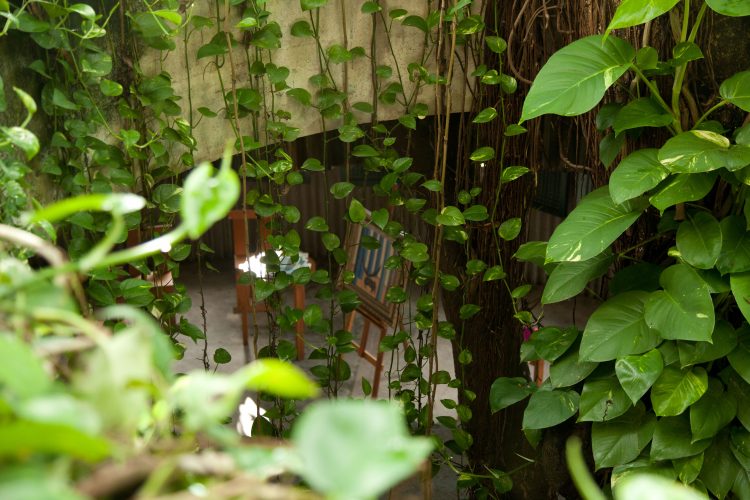
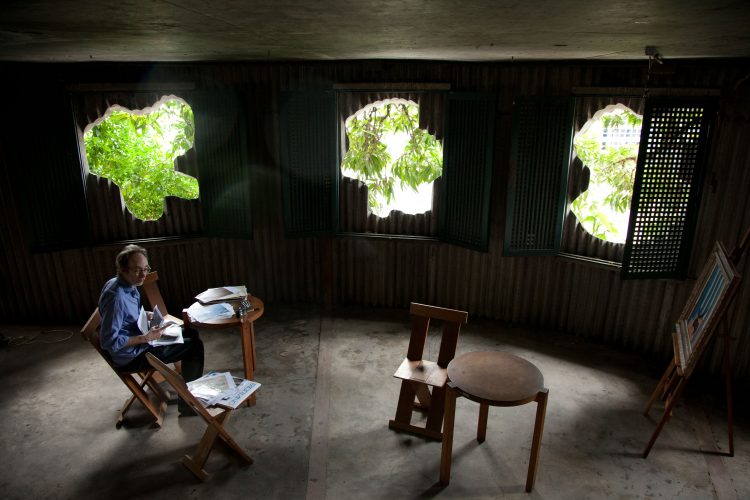




…..
“I first met Helmut in 2006, with Jean-Pascal Flavien. He helped produce a performance of ours titled “Plouf.” The performance took place on two boats off the coast of Rio. The first meeting we had with him was at the beach in Ipanema. I came back to Brazil in 2012, to finally do the residency. I stayed a little over three months. I started learning Portuguese while I was there. Helmut, Amilcar, and I produced an evening of performances or interventions at a theater in Ipanema. I also started a project which I am still working on, and which has taken me twice to the Amazon. Yet the most significant thing that happened, that took place, during this three-month residency was something else, something harder to describe than an activity or an endeavor. + The time I spent in the residency was, in many ways, a break. A hiatus. Though I continued working while I was there, it was not only in a different place but in a different environment. A different atmosphere. And perhaps that’s as close as I can get to defining or describing it. To me, capacete is synonymous with something as simultaneously palpable and elusive as an atmosphere. Every time I return, I encounter a reality whose protagonists change but whose “feel” remains more or less the same. There’s a feeling of openness, of engagement, of trust and sympathy as well, which I identify with capacete. Not that capacete is isolated from the world and its problems, not that it’s in any way an escape, but rather that it opens up onto the world and its problems from within a space that operates differently and with different rules: rules of trust, sympathy, engagement, and openness. These rules are neither stated not even enforced, they are interpreted and discussed, altered and experimented with by each new constellation of visitors, residents, participants. In other words, what capacete inspires and develops is a desire to relate and to relate differently. It develops a sensibility or sensitivity to the other protagonists of our relationships, be they animate or inanimate, material or virtual. Capacete does all of this not by imposing anything on its participants, but rather, by simply inviting them to be both the caretakers and protagonists of its continuous social experiment, one whose strength resides precisely in the inherently fragile and porous nature of its boundaries. Capacete is not a helmet, it’s a tent, and like all tents, it can be pitched more or less anywhere.” -
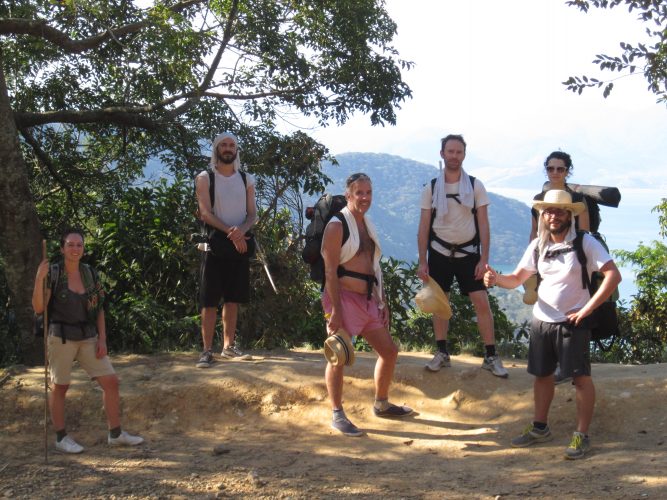
Herramientas para captar la realidad
El punto de partida es el reconocimiento de una realidad que nos supera, pero
con la que podemos entrar en contacto de distintos modos. Disponemos de dos grandes herramientas para acceder a esa realidad: la lógica (para organizarla y hacerla así manejable) y el lenguaje (para hacerla sólida y poder así compartirla). Gracias a ellas (aunque no sólo con ellas) construimos teorías científicas y sistemas filosóficos, discutimos y argumentamos. Es decir, construimos nuevas herramientas de las que nos servimos para tratar de domesticar la realidad.
La justificación de este artificio es práctica: necesitamos manejar la realidad para poder operar sobre ella, aunque al manipularla la desfiguremos en alguna medida.
Teniendo en cuenta esta radical diferencia entre una realidad continua, compleja y gigante, y unas herramientas que la fragmentan, simplifican y reducen a un tamaño manejable,
Vaz Ferreira habla en numerosas ocasiones de la inadecuación del lenguaje y del pensamiento discursivo para expresar la realidad, y, en general, de la insuficiencia de los sistemas para pensar el mundo que nos rodea. La sistematización, por una parte, es una tendencia natural del espíritu humano que (“todo lo completa, todo lo simetriza”) y, por otra parte, es una tendencia que da sus frutos en muchas ocasiones (la sistematización aporta simplicidad y, en consecuencia, facilidad para el manejo y capacidad de previsión). Pero seríamos dogmáticos si creyéramos que esa herramienta tan útil puede sustituir a lo real, o que puede aplicarse con igual éxito a cualquier realidad. Dicho de otro modo, ya que los sistemas simplifican, siempre hay algo de la realidad que el esquema no atrapa; y ya que cada situación concreta es distinta, el querer aplicar un sistema ya hecho en lugar de ponerse a la tarea de pensar equivale simplemente a negarse a mirar la realidad que se tiene delante.
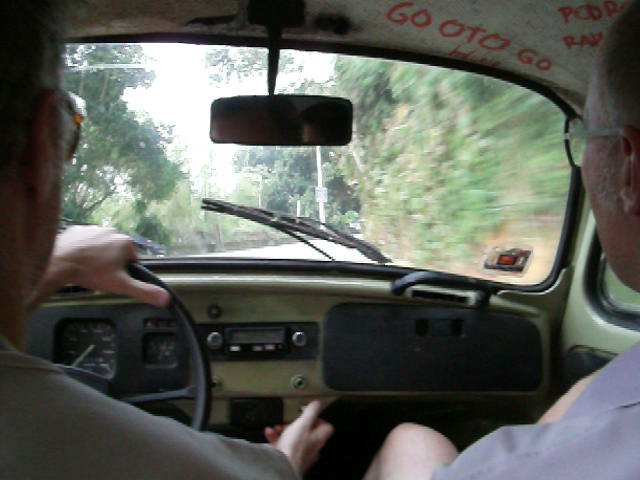

Nicanor Aráoz (Buenos Aires, 1981) produces objects, installations and sculptures using as reference images from comics, imagery from the Internet and romantic mythologies taken from gothic art. In his works, procedures involving the making of a surrealistic object, such as the assembly of dissimilar elements and a oneiric component, take on frantic forms resembling nightmares where pleasure and pain seem to merge. Aráoz uses materials as if they were to expiate sadistic sensations and takes them to the utmost limits of expressivity and torsion. In narrative scenes, he mixes plaster monsters, amorphous masses of resin, trainers, neon lights and biscuits with embalmed cats, mice and birds, thus shaping a world of emotional psychedelics with visual references to the domestic environment of an adolescent.
Jonas Staal (1981) is artist and founder of the artistic and political organization New World Summit (2012-ongoing) and the campaign New Unions (2016-ongoing). Staal’s work includes interventions in public space, exhibitions, theater plays, publications, and lectures, focusing on the relationship between art, democracy, and propaganda. Recent solo exhibitions include Art of the Stateless State (Moderna Galerija, Ljubljana, 2015), New World Academy (BAK, basis voor actuele kunst, Utrecht-Centraal Museum, Utrecht, 2015) and After Europe (State of Concept, Athens, 2016). His projects have been exhibited widely, among others at the 7th Berlin Biennial (2012), the 31st São Paulo Biennale (2014), and the Oslo Architecture Triennial (2016). Recent books by Staal include Nosso Lar, Brasília (Jap Sam Books, 2014) and Stateless Democracy (BAK, 2015). The artist is a regular contributor to e-flux journal and completed his research Propaganda Art in the 21st Century at the PhDArts program of the University of Leiden.
+ Parallel Cities, Parallel Histories “During my 2012 experience in Capacete, São Paulo, I developed the project Nosso Lar, Brasília. A friend had taken me for various walks through the city, to try to make me aquainted with its complex urban infrastructure. In various corners we encountered evangelical and spiritist centers, the latter of which struck me due to posters and imaginery of a futuristic society, which I imagined to be a depiction of some form of “heaven.” How was it, I wondered, that the left had so much difficultly imagining a post-capitalist society, whereas the spiritists seemed to have no hesitancy to use three-dimensional modelling to represent their ideal, eternal and utopian looking world? I began researching the background to these images, and quickly came across the work of psychographer Chico de Xavier, that was a messenger on behalf of the dead throughout his life: writing countless books on behalf of wise spirits and diseased poets. Most of the stories he transcribed related to Nosso Lar, or “Our Home”: a hyper-modernist regeneration colony in the afterlife, where spirits either prepare for their re-incarnation on earth, or to move further into new levels of spiritual awakening. I had not yet made the comparison between Nosso Lar and the Brazilian modernists, such as Lucio Costa and Oscar Niemeyer. But when I was preparing for a travel to Brasília, and a psychographed map of Xavier depicting Nosso Lar accidentally was laying next to a map of Brasília, the resemblance struck me. The engineered nature of both cities seemed nearly identical. Had there been any connection between the spiritist movement around Xavier and the Brazilian modernists? Did these two city models – one in the beyond, one in our present-day reality – have anything to do with one another? Did they match size, function, ideology?… The answer was neither yes or no. The models had much to do with one another, too much almost. But just not enough to say that they were the same. They form parallel cities, and parallel histories, hovering over and nearby one another – touching at unexpected moments. And just as there is not a single narrative that could account for the endless cities within the city of São Paulo, I realized that I had to develop an approach that could narrate the history of both, without ever becoming the same.” — Nosso Lar, Brasília was developed between 2012-13, co-produced by Capacete, the 31st São Paulo Biennial, and Extra City Antwerp. The resulting installation was presented from 2014 onwards, and the book of the same title published by Capacete and Jap Sam Books, Heijningen, the Netherlands. -
Ícaro Lira vive e Trabalha em Fortaleza-CE e São Paulo-SP.
Artista Visual, Editor e Investigador, com pesquisa desenvolvida no âmbito do Documentário Experimental. Estudou Cinema e Vídeo na Casa Amarela-UFC, Fortaleza (CE), Montagem e Edição de Som, pelo Instituto de Cinema Darcy Ribeiro (RJ) e na Escola de Artes Visuais do Parque Lage (RJ) participou dos Programas Fundamentação e Aprofundamento e em 2016/2017 do PIMASP – Programa Independente do Museu de Arte de São Paulo (SP).
Since 2011, I have participated in exhibitions and residencies in institutions such as: Parco d’Arte Vivente, Turin, Italy; La Maudite, Paris, France; SFMOMA, San Francisco, USA; Casamata, Parque Lage, Capacete, Oi Futuro RJ, Galeria A Gentil Carioca, Rio de Janeiro, Brasil; CCBNB-BR, Fortaleza, Brazil; Tomie Othake, São Paulo, Brazil, and others.
In 2015, I graduated with an MFA from the School of Missing Studies, Sandberg Instituut, in Amsterdam (NL). I have participated in a.pass in Brussels in 2016.
I am currently based between the Netherlands and Brussels, Belgium.
Brazilian artist, art-educator and cultural stirrer, graduate in dance, mainly interested in articulating different forms and conditions to develop sensible material and experience.
“CAPACETE was the second of a series of six residencies I participated in 2012/2013, in which I was developing a gestural, behavioral, choreographic and conceptual research I was calling “Escavações” (Excavations). Once I was able to have a lot of proper time to arrange my activities along all of those residencies, and having CAPACETE’s context in between of two others where I was and would be pushed hard into practical experimentation, I decided to make Rio (a very familiar place for me, because I lived there for 10 years) a place/context to be more quiet and still, reading more, listening more, paying attention and so on. I remember the moments of the days I enjoyed the most were like being at the kitchen with other artists, listening to their desires, concerns, struggles and efforts, cooking and talking about nothing precise, chit-chatting with the woman that used to clean the common spaces of the apartment (I’m sorry I don’t remember the names of much of those companions, but for me what mattered were their presences), and also when someone was being visited by outsiders; it was great having time to give time to the presence of the other. Maybe that’s the clearer remembrances (maybe more as feelings) I have from the time at CAPACETE, but nonetheless, despite blurred and apparently artistically meaningless, those experiences brought me thoughts and motivations that were deeply important for the sequels of my excavations.”
“In many ways Capacete was an opening chapter to a series of visits to the country. I have been coming back every winter since, developing different projects around themes of nature and corruption in the north east region of Brazil. I did a solo show titled ‘Condominium’ at Akershus Kunstsenter in Norway in 2015 where I exhibited a project looking at massive holiday apartment complexes, built for Norwegians, close to Natal that came to a halt due to financial crisis and a money laundring scandal. At the moment I’m working on an artist book that connects images from trips to Brazil. It will be a lyrical documentary of a region, where contemporary ruins destroyed by financial crisis and corruption are combined with images of landscapes and of hallucinatory nature. It will also include a CD of sound recordings.”
Jimmy Robert (born 1975) works in a range of media—including photography, sculpture, film, video, and collaborative performance—gently breaking down divisions between two and three dimensions, image and object. Robert’s work is guided by an interest in the body and the poetic potential of ephemeral materials such as paper and tape. Creating form through gesture, he draws inspiration from artists such as Yvonne Rainer and Yoko Ono. His exploration of moving bodies, crumpling paper, and repetitive gestures, in works that feature actions such as a hand tearing tape from skin or fingers rubbing a text, has come to define him as an artist of touching.
+ There is also a still of the performance I did at the teatro Ipanema with the group of artists/community around Capacete at the time. Finally, a production still of the video installation Vanishing point showed at the 8th Berlin Biennial where I filmed on super 8 the amazing drag performer Erika Vogue doing a dazzling performance of Bate cabelo throughout the modernist edificio Capanema. We also went to Ilha Grange as a group which was a simply unforgettable moment, here you see Helmut with a Penguin which had somehow lost its way to the south.” -
gview file=”http://capacete.org/wp-content/uploads/2012/03/CAPACETE20ANOS-PAGINAS-Keller.pdf”
Keller works with different media, filming, researching, writing. Now he is a profesor in Geneva and other places.
[ess_grid alias=”Galeria de foto” layers='{“custom-image”:{“00″:”4197″,”01″:”4195″,”02”:”4193",”03″:”;4191″},";custom-type”:{“00″:”image",”01″:”image”;,”02&;quot;:”image”,”03″:”image”},”use-skin”:{“00″:”-1″,”01″:”-1″,”02":”-1″,”03″:&;;quot;-1″;}}’][/ess_grid]
Daniele Marx lives and works in Amsterdam. Her work engages time based practices mainly in the following areas: conceptual art, socially engaged practices and collaborative projects. This practices is presented from various media: publications, events, other formats. From 2008-2010 she holds an Master of Fine Art at AKV St Joost in the Netherlands. Since 2003 she cooperates with the Fine Art UFRGS at extension project Lost in the Space – Ways of Thinking the Sculpture coordinated by Dr. Maria Ivone dos Santos and developed the Project Meio, co-authored with the artist Marcos Sari both in Porto Alegre, Brazil.
+ -
Mora e trabalha no Rio de Janeiro. Vivian Caccuri utiliza o som como veículo para cruzar experimentos de percepção em questões relacionadas a condicionamentos históricos e sociais. Por meio de objetos, instalações e performances, seus trabalhos criam situações que desorientam a experiência diária e, por consequência, interrompem significados e narrativas aparentemente tão entranhadas como a própria estrutura cognitiva. Vivian já desenvolveu projetos em diversas cidades do Brazil e exterior, icluindo Amazônia, Accra, Detroit, Helsinki, Vienna, Veneza, Kiev, Valparaíso entre outras.
+ -
“I am a freelancer as an Editor and Curator, I have my own publishing house, with Laura Daviña (Edições Aurora) and I am studying a master degree at Museo Nacional Centro de Arte Reina Sofía, in Madrid. “How to live together”, “how to waste my time”, “how to deal with contradictions”? Capacete`s residency gave me some experiences that helps me in these big insoluble questions. Also gave me excelente memories and people, and coexistence with Helmut´s generosity and his special way to live and create community.”
Felipe Meres was born in Petrópolis, Brazil in 1988 and currently lives and works in New York. Solo exhibitions include The Telomeric Cut at Mendes Wood DM, São Paulo (2017) and Fsision at Company Gallery, NY (2016). His work has been shown in venues such as Cisneros Fontanals Art Foundation, FL (2016); Shulamit Nazarian, LA (2016) and Lisa Cooley, NY (2016). He was an artist in residency at the ArtCenter/South Florida, FL (2016); SÍM, Reykjavik, Iceland (2012) and Escola de Verão, Capacete, Rio de Janeiro (2012). He holds an MFA from the Milton Avery School of the Arts at Bard College, NY and is currently pursuing a PhD in Anthropology at The New School, NY. He is the recipient of the 2016 Cisneros Fontanals Art Foundation Grants & Commissions Award and of the 10th Tom of Finland Foundation Emerging Artist Grand Prize.
A prática artística de investigação e pesquisa de Rodrigo Garcia Dutra remonta momentos no tempo que influenciaram a estética do mundo como nós o percebemos hoje. Rodrigo constrói uma coleção de fatos, objetos encontrados, presentes e lugares em que esteve para então os trabalhar através de desenho, pintura, fundição de bronze, traçados de carvão , edição de vídeo e arranjo / re-arranjo deles no espaço. Dessa forma reavalia esses momentos ou situações , lançando uma nova luz sobre eles.
“We belong to capacete history as capacete belong to ours”.
Beto Shwafaty is an artist and researcher based in Brazil. He has been involved with collective, curatorial, and spatial practices since the early 2000s, and as a result, he develops a research-based practice on spaces, histories and visualities, that connects formally and conceptually political, social and cultural issues that are converging to the field of art.
“Capacete is like a studio without walls. It is a multibrain outside of our heads. A network. It is also like a community. It is like being lost, and find the path (maybe not the one you were looking). It is never the same as before. It is food. It is exchanges in micro scale which you will carry with you. It is risk and failures, challenges and construction. Capacete is a house, walls and roof. It is friendship, a multitude of diversities, creating fluxes contexts. It is.”
Crítico, curador e historiador da arte. Atualmente trabalho como curador no Museu de Arte Contemporânea de Niterói, no Rio de Janeiro. Doutor em História e Crítica da Arte (UERJ). Escrevo para a revista ArtNexus. Professor do Colégio Pedro II. Vivo e trabalho entre o Rio de Janeiro e o mundo. [Critic, curator and art historian. Curator at the Contemporary Art Museum of Niterói, in Rio de Janeiro. PhD in History of Art and Critic (State University of Rio de Janeiro). Writes regularly for ArtNexus. Lecturer in Colégio Pedro II. Lives and works between Rio de Janeiro and the world]
Pedro Victor Brandão (*1985, Rio de Janeiro). He is author and artist. He works with photography, performance and social practices. He has a degree in Photography at Universidade Estácio de Sá, (UNESA, Rio de Janeiro, 2007-2009) and has attended to liberal study courses at Escola de Artes Visuais do Parque Lage (Rio de Janeiro, 2005-2010). Since 2003, he has been developing works about new meanings for the technical image today, researching iconoclasm, oblivion, and the relation between truth and image regarding different political landscapes. His works have been shown in many institutions in Brazil and abroad, including Museu de Arte Moderna (Rio de Janeiro – Brazil), Casa França-Brasil (Rio de Janeiro – Brazil), SESC Vila Mariana (São Paulo – Brazil), Portas Vilaseca Galeria (Rio de Janeiro, Brazil), Niklas Schechinger Fine Art (Hamburg – Germany). He was artist-in-residence at Lastro Centroamérica (Ciudad do Panama, Panama, 2015); ZK/U – Zentrum für Kunst und Urbanistik, (Berlin, Germany – 2014); Halfmannshof, (Gelsenkirchen, Germany – 2013); Terra UNA (Liberdade – Minas Gerais, Brazil – 2013); and Cité Internationale des Arts (Paris, France – 2012). From 2007 to 2012 he collaborated with different collectives (Laboratório Tupinagô, OPAVIVARÁ!, Epistomancia and Agência Transitiva). His work is represented by Portas Vilaseca Galeria (Rio de Janeiro) and Sé (São Paulo). He lives and works in Rio de Janeiro.
Ivana Vollaro nació en Buenos Aires, Argentina en 1971. Vive y trabaja en Buenos Aires.
Estudió Artes en la Facultad de Filosofía y Letras (1993-1997) y Derecho (1989-1992) en la Universidad de Buenos Aires.
“Tentativa de esgotar a Universidade de Verão”
o Capacete
a Glória
a rua Constant
a rua Russel
a vista da rua Russel + o Pão de açucar o barulho dos aviões os aviões o gaspacho de boas vindas os jantares os almoços os corpos o suor os corpos sudados o calor sofocante o ventilador azul a filosofía do Amílcar o Amílcar os passeios o Largo do Machado o Perec carioca a Lapa a subida a Santa Teresa os desenhos do Martín o Martín as fotos as fotos da Luz o tijolo da Luz a Luz as visitas as falas os risos as piadas as fofocas as conversas as conversas moles o círculo da Sofia a Sofia o signo de pergunta da Suely as paredes da Suely a Suely os sucos do Amílcar os cafecitos as xícaras dos cafecitos os biz as festas as mil festas as cachaças os mil tipos de cachaças o samba o sambôdromo as batucadas as cachoeiras o parque do Flamengo os assaltos o Inhame a mostra no Inhame os workshops as palestras o blog da universidade os trabalhos da Renata as fachadas da Renata a Renata o árabe do Largo de Machado as pizzas do Chico o Cervantes Tacacá os biscoitos salvadores as intervenções a arte contemporânea as curadorias de Raphael os olhos de Raphael o Raphael aquele pôr-do-sol em Arpoador o vestido da Keila a leitura da Keila a Keila o gelo as cervejas as latas das cervejas as lixeiras azúis o lixo o plástico as facas os livros do Amílcar as projeções as telas improvisadas do Daniel as acuarelas do Daniel o Daniel os convidados a bienal tropical do Pablo León de la Barra o Pablo a escada encostada da Constant o bar do Zé as anotações todas as posibilidades os errores o quadro negro da Renata os playlists do Bhagavan o Bhagavan os vizinhos o som dos vizinhos a lanchonete da Constant a padaria da Gloria o carro do Helmut as compras dos churrascos a logística dos churrascos os churrascos as linguiças os choripanes os espetinhos a preparação das saladas as listas de preços a praia os sons o aparelho do som do Bhagavan os vídeos da Sofia as torneiras da Russel a mangueira os ratos gigantes as baratas o raquete mata-mosquitos os mosquitos o off o barulho a luz do dia as luzes da noite o Pierce do Benjamin o Benjamin os companheiros os colegas os artistas os trabalhos a obra as obras todas as obras os diagramas do Pedro o riso do Pedro o Pedro as estátuas do Segio Martins o Sergio o facebook o google os sites os sites do Felipe o Felipe os links o wordpress.com da universidade os álbumes do Picasa os e-mails os convites a poesia do Ricardo Basbaum o Ricardo as oficinas o programa os participantes as anotações os cadernos o vídeo do Beto as perguntas do Beto o Beto os tipos de bancos da Russel as caderas triples de Pedro as havaianas os pés descalços o gudi-gudi o clima-tempo os cardápios o wi-fi os mac os pen-drive os HD os chãos os cheiros as luas o elevador da Russel os copos variados os mails de Daniel os letristas da Kaira a Kaira as sonecas os chopps as frutas os celulares os celulares tocando os cigarros os chicletes os vídeos do Amílcar os vídeos do Fabrício o corpo do Fabrício o Fabrício o metrô os ónibus os taxis o morro do Pasmado a naturaza o Jardim Botánico o Parque Lage os predios os predios que cairam as ruas os caras da rua a rua do Catete o pre-carnaval os blocos de rua o karaoke os amigos os namorados as namoradas as novas amizades os encontros casuais as paixões as voz do Amílcar a camiseta furada do Helmut os muros abertos da Alana a Alana o açaí a praia de Ipanema o vídeo do Nicanor as esculturas do Nicanor o Nicanor os telefones tocando a chuva as noites os dias o ar o banheiro da Russel os banheiros da Constant o lavajato da Constant a igreja Batista as contas os reais os cartões as dívidas as dúvidas o português o inglês o francês do Amílcar o español o portunhol da Ivana a Ivana os .pdf as cámeras as obras do Anton as obras coletivas do Anton o Anton a mesa da Constant as bananas as duchas os tijolos as campaninhas inexistentes os golpes nas portas as gambiarras os horarios às 16 hs às 17 hs as madrugadas o improviso os desejos os pensamentos as ideias as novas ideias o prazer as frustrações as mudanças as perguntas as respostas os bocejos as concluções as dores de cabeça as percepções do Lucas o aterro do Lucas o Lucas os leques o projetor todos os cabos os sites os links as referencias os contatos o balão letrista o jeito do Neto o Neto as luas a lua cheia o double rainbow o totem do Rodrigo o Rodrigo o jazz os catálogos os livros os livros do Manuel o Manuel o Abre-alas a Gentil o centro carioca as fantasías as saudades as saudades de todos o bloco da universidade de verão os dias que faltam até o próximo verão as mil e uma rações para voltar à universidade de verão a tentativa de esgotá-la a imposibilidade de lográ-lo a alegría de saber-lo. Ivana Vollaro, Rio de Janeiro, fevereiro 2012. -
Choreographer and performance artist born in Rio de Janeiro (BR) and based in Gießen (DE).
“It might be too obvious to start a text like this, but my experience in Capacete was very inspiring, not only because it offered me the opportunity to receive many inputs from different artists, thinkers and researchers in the field of arts, but especially due to the relaxed and affective environment of sharing practices proposed by Helmut, Daniel and Amilcar. I have nice memories from the warm days we spent together during the summer university 2012 (?). And though i don’t have a continuous contact with the artists i met there, once in a while, when we meet in different art contexts is always a pleasure to catch up and remember things together.”
Currently living in State College, Pennsylvania on a Scholarship at Penn State University, doing a Master in Sculpture.
“In 2011, I was invited to Capacete’s Summer Program in Rio amid a vibrant community of artists and thinkers. This experience nurtured my practice and the work I would develop years after and in the present moment. For a short period, a community was created, ideas where exchanged actively and collectively. I was very lucky to be part of this School.”
“I founded ‘de Vluchtmaat’ 3 years ago. I recently started coordinating the programming at the Vluchtmaat. De Vluchtmaat offers a temporary home to 40 refugees in limbo and rents out workingspaces to artists, designers, non-profit organizations and small entrepeneurs. The rent they pay covers all monthly fixed costs like gas, water and electricity. So, we created a shelter for 40 people, that otherwise would be on the street, that doesn’t cost anything to neither the owner of the building or the municipality. Besides de Vluchtmaat functions as a cultural hub in which collaborations between renters and residents are happening. http://vluchtmaat.nl/
+ -